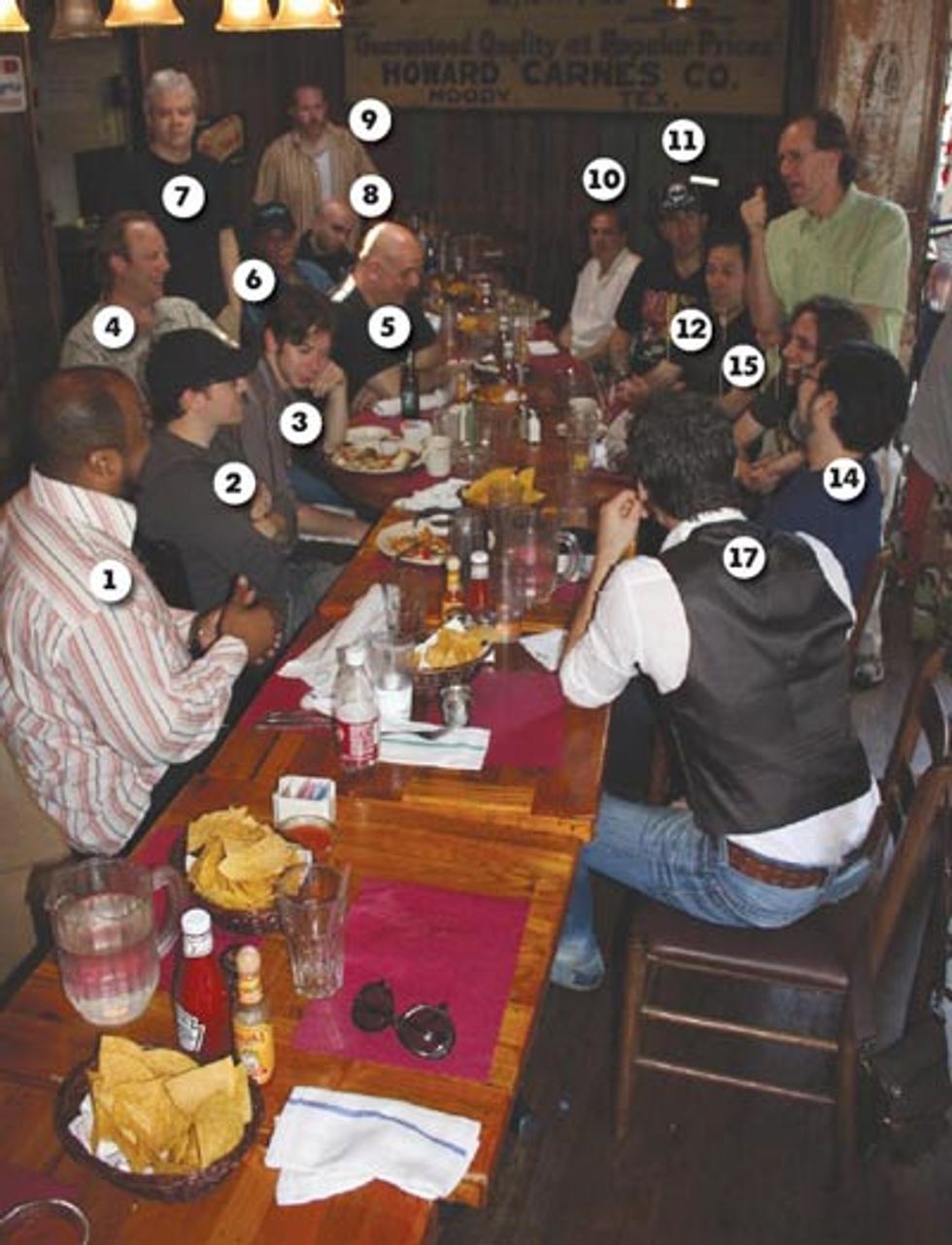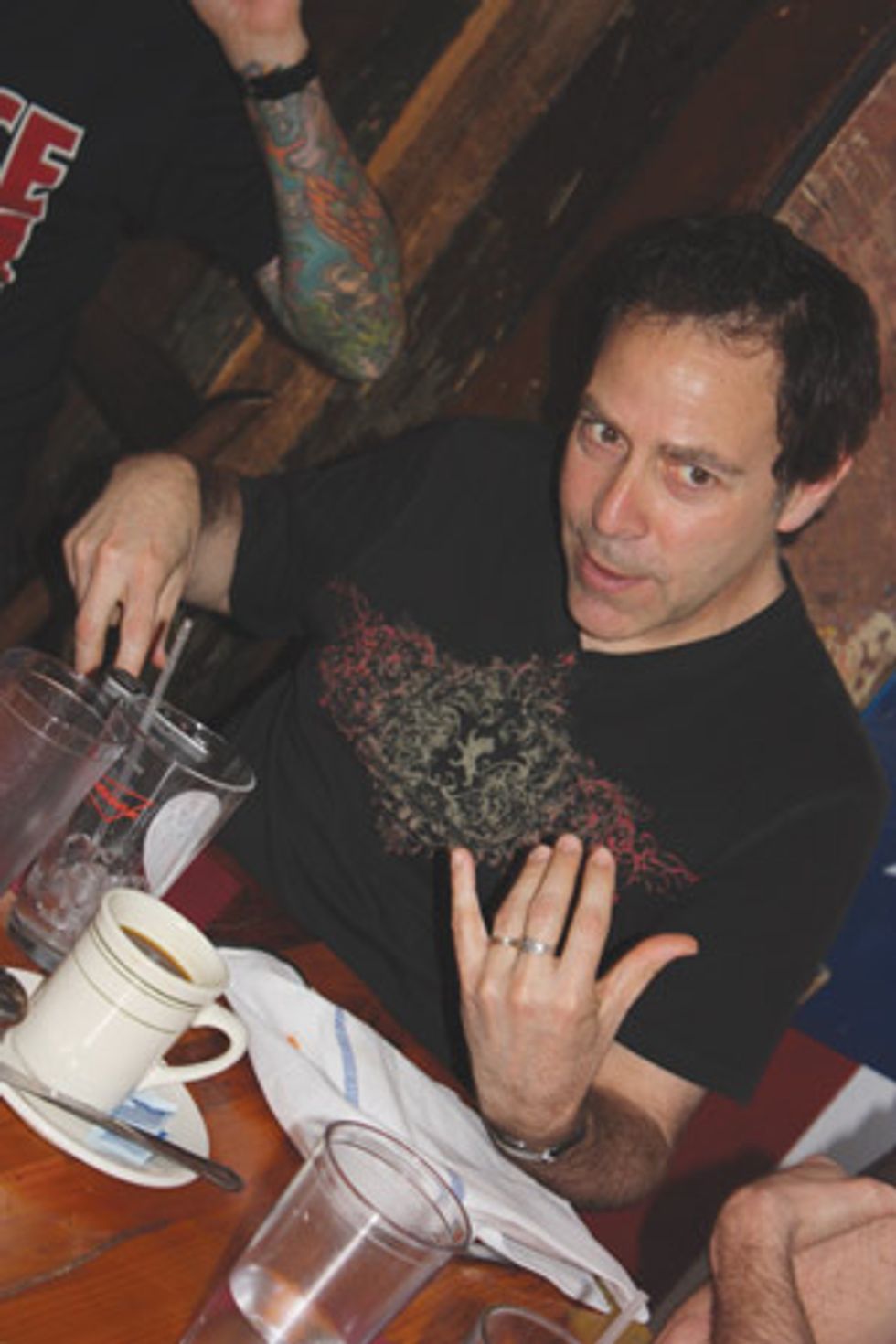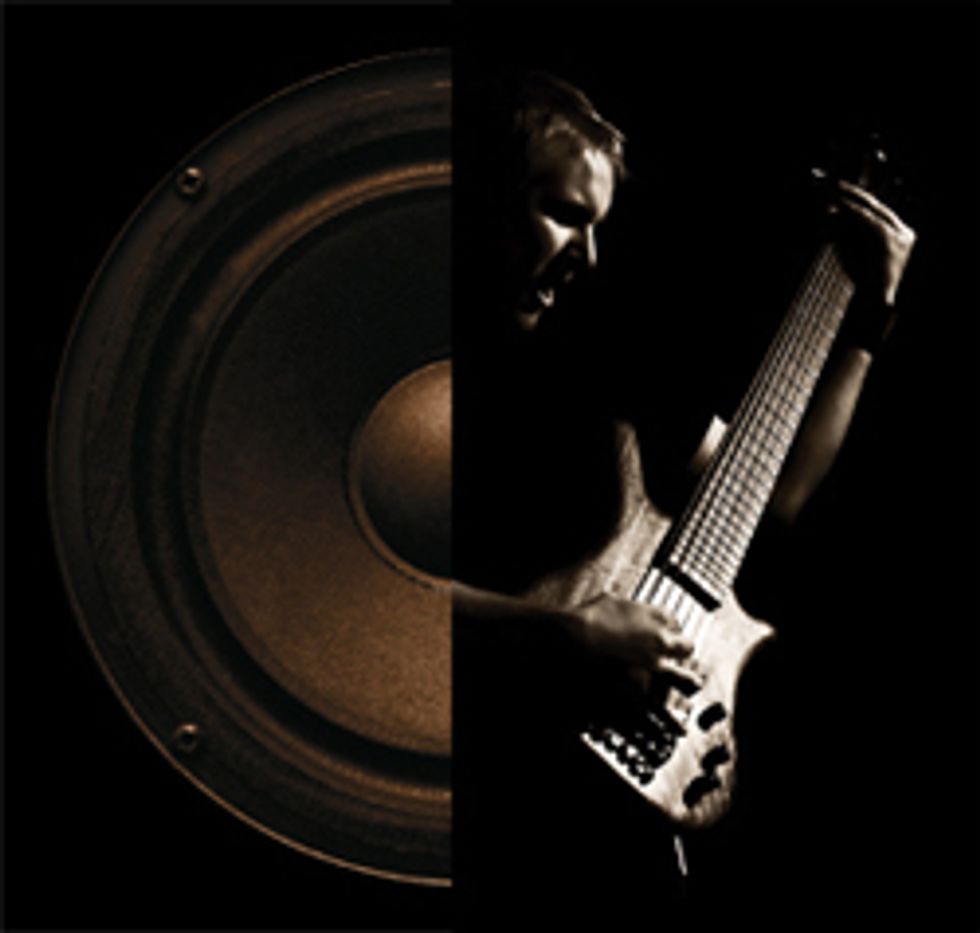An inside look at the monthly Bass Brunch in NYC
 |
|
About once a month, I host a lunch gathering of some of New York’s most experienced working bass players at the Rodeo Bar in Manhattan. We usually number between 20 and 30 and it has become somewhat of an established means of networking and exchanging ideas in the bass community. Discussions are usually informal, but talk invariably turns to the latest gigs, tours, recording sessions and equipment. It is a way to take part in a valuable community experience while gleaning important information about the current state of affairs in the bass world. When Premier Guitar asked me to write a bass-related article for them with the theme of “getting a great bass tone,” I thought that a more moderated discussion at the “Bass Brunch” would be an ideal forum. We met on May 26 and I’d like to refer to some of the comments, which I think will clarify our path to a getting better bass tone.
 | THE COMPLETE CREW 1 - Hashim Sharrieff 2 - Jeff Kerestes 3 - Brian Murphee 4 - Nick Sullivan 5 - Jeff Ganz 6 - “Cricket” Cohen 7 - Tony Conniff 8 - S.A. Sebastian Gnolfo 9 - Bradley Wegner 10 - Frank Canino 11 - Ivan “Funkboy” Bodley 12 - Mike Visceglia 13 - Bruce Gordon 14 - Mas Hino 15 - Jimmy Coppollo 16 - Paul Nowinsky 17 - Chris Anderson |
Let’s start with the instrument itself. My personal feeling is that you can tell a lot about the amplified tone of a bass guitar by listening to it acoustically. Since most basses are made primarily of wood (some are carbon fiber and composite parts), we’re dealing with organic substances, whereby each combination of neck and body, along with the variable of age, can result in dramatically different acoustical properties. When talking to Jimmy Coppolo, luthier and CEO of Alleva Coppolo Basses and Guitars, Jimmy – a frequent bass brunch attendee – spoke of the differences in quality of shipments of wood, moisture content and finishes. We’re talking primarily about alder and ash, as these woods make up the most common types of consumer-oriented bass bodies (there are boutique builders like Fodera, Alembic, Ken Smith, and a host of others, who use more exotic woods, but for the purposes of this article I’d like to talk about the more commonly used varieties).
According to Jimmy, wood with less moisture content tends to sound better and is more stable, be it alder or ash. Wood that holds moisture tends to cover or inhibit the tonal qualities of the instrument. This is one reason why older, vintage instruments are coveted. Jimmy also prefers nitrocellulose finishes, like those found on basses from the fifties and sixties. According to him, they allow the bass’s wood to “breathe” more quickly, which is an asset to good tone. The poly finishes are harder, and, if not applied correctly, can tend to smother tone. The preferences for maple or rosewood necks are personal. Maple necks, like Marcus Miller’s Fender Jazz bass, tend to be brighter while rosewood necks, such as James Jamerson’s Fender Precision bass or my Lakland Joe Osborne Jazz bass, tend to be a bit darker or “warmer” sounding.
If you listen to the bass acoustically, you should be able to determine the relative balance and consistency of the tone. Play all the notes up and down the neck. The bass should be loud enough acoustically and resonant enough for you to be able to hear the definition and duration of each note. There are customary “dead spots” on bass guitars – usually on the G string between the 5th and 7th frets – but this is normal. Any other pronounced dead spots are not normal and should be detectable by scrutinizing the instrument acoustically. Logic then follows that amplifying these unwanted and aberrant properties will result in a decrease in tone.
When the topic of pickups came up during the brunch, veteran bassist and former Johnny Winter sideman, Jeff Ganz, made a cogent argument, saying that an important factor in choosing pickups is the ability to adjust the polepieces individually. Several major manufacturers make pickups with this feature; the advantage of this design is the ability to even-out the response of the pickup to the individual string as desired. Pickups that do not have this feature might have a bias toward one string or another, creating inconsistencies in tonal quality.
Another aspect of pickup choice would be humbucking or non-humbucking configurations. The humbucking setup exists in the Fender Precision -style split pickup configuration, or in active pickups. This does not occur in a passive, two single-coil pickups unless both pickups are turned up all the way, as rolling off the volume of one pickup results in hum that would obviously interfere with your tone.
I prefer a passive setup, as do many other professional bassists. On my 1962 Fender Jazz and my Lakland Joe Osborne Jazz basses, I leave both pickups turned up full (in humbucking mode) and rely on preamps to fine tune the high, middle and low frequencies.
There are three types of strings to consider when thinking about tone. If you’re a fan of old funk and roots music – think James Jamerson or Duck Dunn – then you probably want to play with flatwound strings. These have less sustain and a stronger fundamental – the primary note before any overtones meld with the sound. If you’re into more modern bass sounds, like Marcus Miller or Anthony Jackson, then you might consider roundwound strings. These are brighter, have more sustain and provide overtones as part of their sound, making them more suitable for slap-style playing. A less commonly used string is the half-wound, which as you might guess, gives a sound somewhere between flats and rounds. The brunch crowd was mixed in terms of personal preferences; my personal choice is D’Addario roundwounds, which I find dependable, long lasting and rich in tone.
What the Bass Brunch Gang Says
 Mike Visceglia |
There has been significant progress made in cable technology and an important contribution has been made by Planet Waves. Rob Cunningham, Planet Waves product specialist, explained these advances. By attaching shielding to the ground on the amplifier side of the cable and having dual layers of shielding, Planet Waves has virtually eliminated ground loops and noise interference, creating a transparent signal that is “direction oriented.” I use these cables both live and in the studio and have found them to be first rate. Using what they call “In = Out” technology – essentially using low capacitance – they’ve made cables that transmit the full sonic spectrum. This kind of transparent transmission is obviously critical in the ability to control one’s tone.
Bass brunch-ers, Chris Anderson and Paul Nowinsky (Ricki Lee Jones, Les Paul, Keith Richards), were quite vociferous about the use of the Radial JDV direct box. It is what they call an “honest” DI that will send out to the front of house soundman or recording engineer exactly what you’ve given them. My conversation with Peter Janis, president of Radial Engineering, shed some light on the unique qualities of their JDV direct box. It was explained to me that all DI boxes have one thing in common – they are constructed with negative feedback loops that have been considered an intrinsic part of the design, but negative feedback loops impede signal flow.
While high-end audio companies like Neve boast that they’ve created circuitry that’s “almost free of feedback loops,” Radial’s JDV box has no feedback loops. It also has 30V internal rail voltage, whereas a typical DI box has 3V. An average passive bass puts out about 1V, but an active bass can put out as much as 10-15V. You can easily see how the common DI box can be overloaded, thus diminishing signal flow and consequently, tone. Having an internal rail voltage of 30V eliminates all possibilities of overload. The Radial JDV also has a feature called “drag control” that matches to the impedance of your instrument. So what you have with the Radial JDV is a box that passes your signal and sound with the greatest degree of fidelity and virtually no coloration. It was unanimously agreed that a low-quality DI box could subvert all of the gains made in the preceding tonal chain.
Obviously, there have been great gains in the field of bass amplification. I had a lively discussion with Dave Boonshoft, CEO of Aguilar Amplification and frequent bass brunch attendee about this. I like his idea of thinking of bass amplification as “completing an incomplete instrument.” In other words, the bass guitar doesn’t stand on its own like a saxophone or violin. It needs an amplifier to “complete” it. With that in mind, Aguilar thinks very thoroughly about the subtleties of the instrument, the attack, how well the note opens up and the replication of natural overtones when designing amplifiers and tuning speaker enclosures. It helps that the CEO of the company is a bass player himself.
One of the bigger advancements in amplification, specifically among Aguilar designed amps, has been the development of non-distorting preamps that can faithfully reproduce bass tones below 200Hz. Most consumer oriented preamps produce lowlevel distortion that will color the tone of the bass. Another advance in amplification has been in the area of onboard EQ. With more precise graphic and parametric EQs, one can target frequencies that need to be addressed.
An interesting point was made regarding equalization at the bass brunch by Ivan Bodley, bassist for soul legend Sam Moore. He said that if you invert the normal smiley-face EQ curve to a frown-face curve with 500Hz as the high point, you generally will have a tone that cuts through most live band performances. He and others at the brunch felt that 500Hz seems to be the most important definition point in order for the bass to sit in the right place on the spectrum.
Veteran NYC bassist and bass brunch participant, Frank Canino, made a great point regarding live bass tone. He said that you should shape your tone according to the character of the bass drum. In other words, if the bass drum has a high pitch point, you can warm it up by boosting lower frequencies on your EQ curve. Conversely, if the bass drum is muddy, you can make it more defined by boosting middle and higher frequencies. This is a good rule of thumb to improve the live sound of any rhythm section.
 Jeff Kerestes (left) and Brian Murphee contemplate the Zen of tone |
Larry also said that EA uses almost 100 percent neodymium magnets, which create a stronger magnetic field. Aguilar cabinets are much more varied in size and are tuned to take into consideration the specific needs of the style of music that you’re playing. They make enclosures of many sizes, up to their DB810 cabinet for louder players that demand a “stiffer midrange,” according to Dave Boonshoft. Their goal is “coherency” of tone across all styles of playing through the detailed design of the enclosures for their various speaker configurations.
The Zen
 As we complete our journey in search of bass tone, let me try to elaborate on what I consider the most important aspect of tone, and yet its most intangible corollary. You can take the most well made bass, most transparent cables, preamp, amp and cabinet combination and have the greatest players all play on the same equipment – yet each will have a completely different tone! Why is this? Why do Jaco, Jamerson, Marcus, Will Lee or Anthony Jackson sound so unique? Nothing can create tone more than the player’s personal relationship to music and his or her instrument. The mind, hands and interpretive skills of the player can literally “draw” tone out of the instrument. A player’s touch can never be adequately analyzed or defined. The years that it takes to perfect the expression of music on the bass in a masterful way is the most complete way to attain great tone. There are no great shortcuts. The technological advancements made in the various aspects that have been discussed are primarily tools that aid in the attainment of tone. Take it to heart and buy all the gear you desire, but don’t try to circumvent the intensive amount of time it takes to learn the art of bass playing. The quick route simply won’t work. Great tone is the possession of the master – go and become one!
As we complete our journey in search of bass tone, let me try to elaborate on what I consider the most important aspect of tone, and yet its most intangible corollary. You can take the most well made bass, most transparent cables, preamp, amp and cabinet combination and have the greatest players all play on the same equipment – yet each will have a completely different tone! Why is this? Why do Jaco, Jamerson, Marcus, Will Lee or Anthony Jackson sound so unique? Nothing can create tone more than the player’s personal relationship to music and his or her instrument. The mind, hands and interpretive skills of the player can literally “draw” tone out of the instrument. A player’s touch can never be adequately analyzed or defined. The years that it takes to perfect the expression of music on the bass in a masterful way is the most complete way to attain great tone. There are no great shortcuts. The technological advancements made in the various aspects that have been discussed are primarily tools that aid in the attainment of tone. Take it to heart and buy all the gear you desire, but don’t try to circumvent the intensive amount of time it takes to learn the art of bass playing. The quick route simply won’t work. Great tone is the possession of the master – go and become one!I’d like to thank everyone at Premier Guitar and all my bass brunch buddies for allowing me the benefit of their experience and knowledge and for contributing to the community and craft of the bass. I’d also like to thank Dave Boonshoft of Aguilar, Larry Ullman of EA, Rob Cunningham of Planet Waves and Peter Janis of Radial Engineering for taking the time to inform me about their great products. Please check out mikevisceglia.com for more on what I’m up to and myspace.com/ for info about the NY bass brunches. Thanks and keep your ears open!
From Your Site Articles

